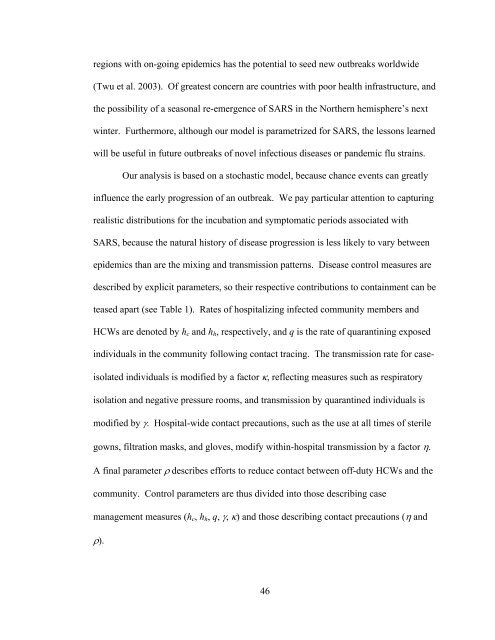K - College of Natural Resources - University of California, Berkeley
K - College of Natural Resources - University of California, Berkeley
K - College of Natural Resources - University of California, Berkeley
Create successful ePaper yourself
Turn your PDF publications into a flip-book with our unique Google optimized e-Paper software.
egions with on-going epidemics has the potential to seed new outbreaks worldwide<br />
(Twu et al. 2003). Of greatest concern are countries with poor health infrastructure, and<br />
the possibility <strong>of</strong> a seasonal re-emergence <strong>of</strong> SARS in the Northern hemisphere’s next<br />
winter. Furthermore, although our model is parametrized for SARS, the lessons learned<br />
will be useful in future outbreaks <strong>of</strong> novel infectious diseases or pandemic flu strains.<br />
Our analysis is based on a stochastic model, because chance events can greatly<br />
influence the early progression <strong>of</strong> an outbreak. We pay particular attention to capturing<br />
realistic distributions for the incubation and symptomatic periods associated with<br />
SARS, because the natural history <strong>of</strong> disease progression is less likely to vary between<br />
epidemics than are the mixing and transmission patterns. Disease control measures are<br />
described by explicit parameters, so their respective contributions to containment can be<br />
teased apart (see Table 1). Rates <strong>of</strong> hospitalizing infected community members and<br />
HCWs are denoted by hc and hh, respectively, and q is the rate <strong>of</strong> quarantining exposed<br />
individuals in the community following contact tracing. The transmission rate for case-<br />
isolated individuals is modified by a factor κ, reflecting measures such as respiratory<br />
isolation and negative pressure rooms, and transmission by quarantined individuals is<br />
modified by γ. Hospital-wide contact precautions, such as the use at all times <strong>of</strong> sterile<br />
gowns, filtration masks, and gloves, modify within-hospital transmission by a factor η.<br />
A final parameter ρ describes efforts to reduce contact between <strong>of</strong>f-duty HCWs and the<br />
community. Control parameters are thus divided into those describing case<br />
management measures (hc, hh, q, γ, κ) and those describing contact precautions (η and<br />
ρ).<br />
46

















